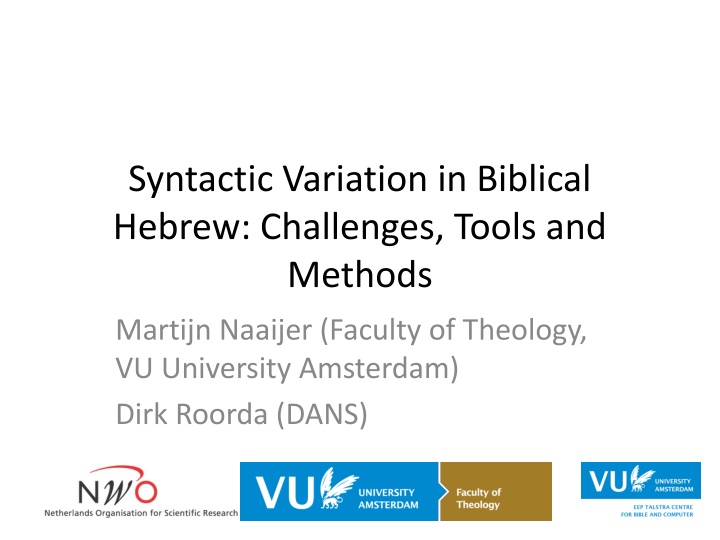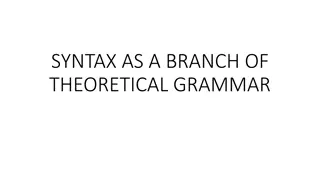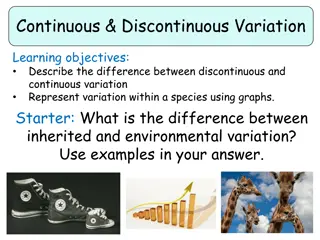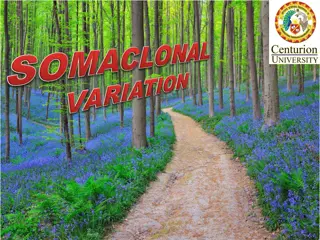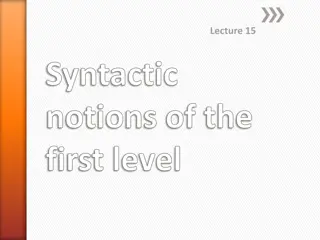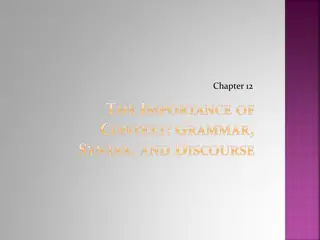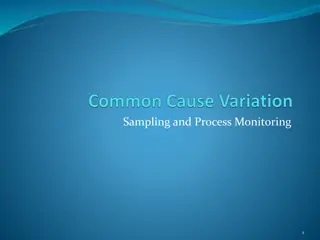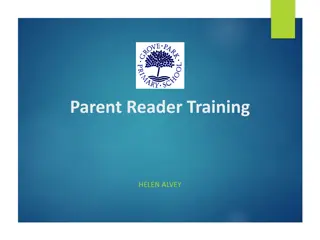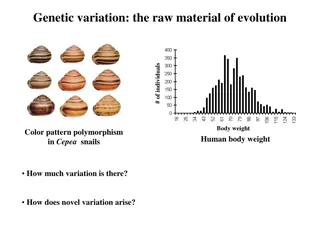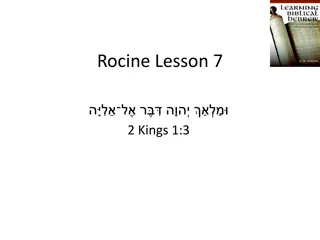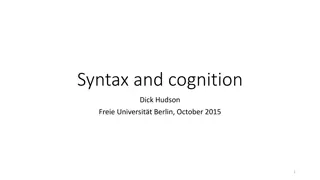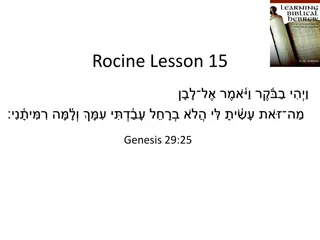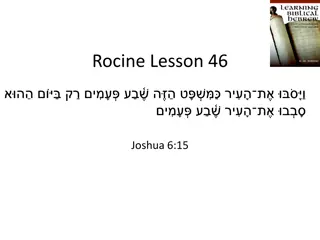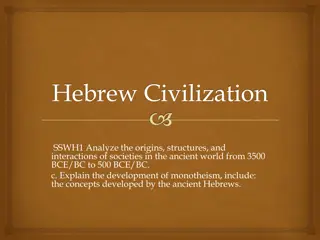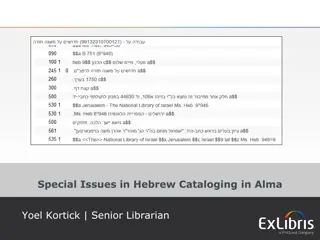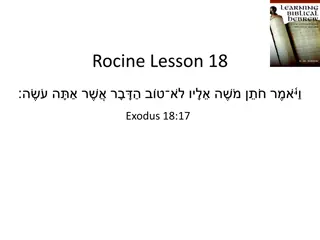Challenges of Syntactic Variation in Biblical Hebrew
Linguistic variation in Biblical Hebrew has sparked a heated debate since 2000, challenging traditional dating methods and assumptions. The Structure Debate delves into syntactic variation and the use of the participle, while considering the differing language in Early Biblical Hebrew (EBH) and Late Biblical Hebrew (LBH). The debate questions the dating of texts, the influence of Aramaic and Persian language, and the complexities of composite texts with a long transmission history.
Download Presentation

Please find below an Image/Link to download the presentation.
The content on the website is provided AS IS for your information and personal use only. It may not be sold, licensed, or shared on other websites without obtaining consent from the author.If you encounter any issues during the download, it is possible that the publisher has removed the file from their server.
You are allowed to download the files provided on this website for personal or commercial use, subject to the condition that they are used lawfully. All files are the property of their respective owners.
The content on the website is provided AS IS for your information and personal use only. It may not be sold, licensed, or shared on other websites without obtaining consent from the author.
E N D
Presentation Transcript
Syntactic Variation in Biblical Hebrew: Challenges, Tools and Methods Martijn Naaijer (Faculty of Theology, VU University Amsterdam) Dirk Roorda (DANS)
Structure Debate: linguistic variation in Biblical Hebrew (BH) Project on syntactic variation Use of the participle in BH Conclusion
Debate Since 2000 there is a heated debate on linguistic variation in BH. Traditional consensus (since Wilhelm Gesenius, early 19th century): Early Biblical Hebrew in Pentateuch and Former Prophets (EBH, pre-exilic, before 586 BCE). Late Biblical Hebrew in Esther, Daniel, Ezra, Nehemiah, Chronicles (LBH, post-exilic). Aramaic and Persian coloring of LBH.
Debate Books of Kings (EBH) and Chronicles (LBH) share several texts. Generally it is assumed that Kings is one of the sources of Chronicles. If this is true, then Chronicles is later than Kings and it is likely that Chronicles language reflects a later phase of BH.
Debate on linguistic dating Can this argument be reversed? Same texts, slightly different language -> Kings is earlier than Chronicles. Is linguistic dating possible? Very tricky issue.
Problems Late books are late, they refer to late events. Are early books early? Composite texts, long-history literature. Long transmission history: -Codex Leningradensis (1008-1009 CE, most important source for most studies, MT) -Biblical Dead Sea Scrolls (2nd century BCE- 2nd century CE)
Problems Composite texts, long-history literature. Late books are late, they refer to late events. Are early books early? Long transmission history: -Codex Leningradensis (1008-1009 CE, most important source for most studies, MT) -Biblical Dead Sea Scrolls (2nd century BCE- 2nd century CE)
Problems in traditional methodology Focus on few rare features (mainly lexical). Maximization of small differences. Focus on MT.
Debate on linguistic dating Alternative explanations: Dialects Social variation Stylistic variation (EBH and LBH are 2 styles) Individual style Transmission of texts
Project syntactic variation Project Does Syntactic Variation Reflect Language Change? Tracing Syntactic Diversity in Biblical Hebrew Texts Focus on syntax, more difficult to manipulate (archaization). Comprehensive approach (many features in all biblical texts). First describe variation, then hypothesize about background of variation. 3 levels (phrases, clauses, text hierarchy)
Case Study: Use of the Participle in BH Smith (1999): Participle used as main verb in: -direct discourse -subordinate clauses (after subordinating particles and circumstantial clauses) Innovation in LBH, participle in narrative also main verb in clauses of past action. Smith gives 4 examples in Esther.
Use of the Participle in LBH Difficult to distinguish these examples in Esther from circumstantial clauses. Same clause structure: w (and) + subject + participle. Is there syntactic variation between EBH and LBH concerning the predicative participle or is it only a matter of semantic intuition? Is there variation at all?
Research question If there is an innovation in the meaning of participle clauses (circumstantial -> action) this may be related to the way the participle clause is embedded in its environment. Is it possible to detect variation in the way the participle clause is embedded syntactically in its environment?
Collecting the data For each participle clause features are listed as encoded in ETCBC database. Ca. 3200 participle clauses. LAF fabric (part of SHEBANQ project (Clarin)). http://shebanq.ancient-data.org/
Data: the grammatical features The features are related to: 1. Embedding in narrative or direct discourse. 2. Verb form of clauses to which the participle clause is related in text hierarchy. 3. The way the participle clause is related to other clauses in text hierarchy.
Data: the samples All participle clauses are grouped in the chapter in which they occur. Each biblical chapter containing one or more predicative participles is one sample -> 762 samples. BA is included. Resulting matrix: 115 variables x 762 samples.
Conclusions There is some variation in the embedding of the participle clause. The strongest variation is between BA and BH, but there is also a slight tendency visible in LBH. Digital tools/multivariate techniques like co- clustering offer many opportunities to search for complex hidden syntactic features for many kinds of variation.
http://shebanq.ancient-data.org/ dirk.roorda@dans.knaw.nl m.naaijer@vu.nl
